
THE OBSTACLE IS THE PATH.
—ZEN PROVERB
I have never known a single person who regularly practiced hanging leg raises and failed to develop a hard and useful set of abs. Ever. The HLR belongs in the training schedule of any hard Comrade.
HLRs are the cornerstone of gymnasts’ abdominal training—so they obviously have a proven track record of producing world-class abs.
Because of its difficulty and effectiveness the HLR was the midsection drill of choice in the underground gyms of Lyubertsi in the 1980s. Street toughs from this small town in the greater Moscow were feared for their rare combo of fighting skills and muscle.
Russian powerlifters and power bodybuilders are convinced that this drill is a fine addition to a powerlifter’s regimen. Squat world record holder in the 181-pound class Igor Shestakov starts and finishes his workouts with 2x20 strict HLRs and has an extraordinarily developed midsection as a bonus to go with his world record.
Elite bodybuilders got on the bar as well. The HLR is the favorite abdominal move of Mr. Olympia Jay Cutler: “Hanging leg raises are the key to midsection development, and are obviously the hardest to do, especially when your legs weigh 200 pounds.” (They don’t and make up about 1/3 of one’s bodyweight, but the poor leverage imposed by their length makes them feel like they do.)
The HLR works the waist super-intensely with peak activation reaching 163% for the EO and 300% for the lower RA!46
There are a dozen other great reasons to pursue HLRs I can think of. I will hit them one at a time, when you are resting between your sets.
Let us establish what constitutes a legit HLR:
• The arms remain straight at all times
• Look straight ahead and do not tilt your head back
• Start from a dead hang and move at a controlled, momentum free cadence
• Keep the legs straight or nearly straight
• Touch your shins or feet to the bar
Anything less is wishful thinking.


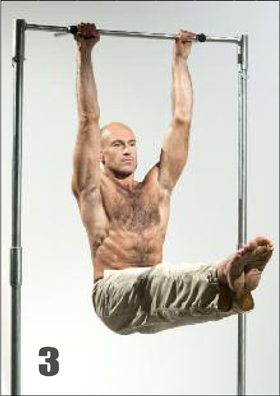
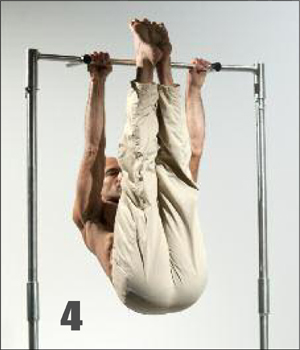
A legit HLR. Anything less is wishful thinking.
Needless to say, you will not be starting there. Months of Hardstyle breathing and Hardstyle sit-ups must come first. As well as flexibility training for your hamstrings and, to a lesser degree, for your back. If you can’t touch your toes while keeping your legs straight standing or sitting on the ground, you will not stand a chance up on the bar. Don’t undertake HLRs until your toe touches are adequate.


You have got to be kidding me, Comrade!
The next step is learning to take the arch out of your lower back and the slack out of your body to assume the so-called “hollow position” from gymnastics. British gymnastics coach Lloyd Readhead stresses that this position is “essential to the safe and successful development of a great number of gymnastic skills and the ability to retain this shape must be developed throughout the gymnast’s career.”
I will remind you that “hollow” does not refer to sucking in your stomach! This posture looks like a very open “C”: the athlete’s straight arms and legs are stretched out like a diver’s but the tension in his abs “shrinks” the front of the body and brings the arms and the legs towards each other a little. The tailbone is maximally tucked in and the chest is sunk in. Not a pretty posture but a strong one.47


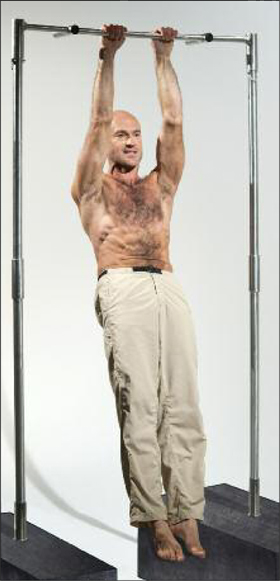
From a dead hang to a “hollow position”.
We have a special way of learning the hollow position: hang on a pullup bar and Hardstyle breathe. Use a narrow grip: you should be able to almost touch the tips of your thumbs together if you tried. Comrades with huge upper bodies will have to go wider, but they still should grip narrower than their shoulders. The purpose of this narrow grip is to pre-stretch your lats and thus unload your shoulders. Another Hardstyle subtlety to fire up your lats even more, is to use a thumbless grip.
It is even better to start this and all other HLR progressions on narrow, shoulder width or slightly narrower, parallel bars. The semi-supinated grip makes the exercise easier and is friendlier to the shoulders. Not a bad choice when you are learning the moves.
Your arms must be straight at all times in this drill and in all other HLR evolutions. Flexing the elbows reduces the effectiveness of the exercise and threatens the shoulders. A Hardstyle tip: tense your triceps and keep them tensed.
Keep your legs straight as well, your kneecaps pulled up and your toes pointed. For greater effectiveness squeeze a small water bottle, empty but with a cap on, between your legs: right above or below the knees or between the ankles. This dramatically increases the midsection tension. Feel free to use the water bottle in your hanging leg raises as well, when you get there. It also works like a charm for pullups. Instructors at one of the federal law enforcement agencies that hire me as a subject matter expert have had great success boosting their recruits’ pullups with this simple technique.
Take a breath and start Hardstyle breathing in the familiar manner of ramping up short hisses. It will be a lot harder than on the ground, as now your midsection muscles, in addition to their usual challenges, have to fight the gravity to bring your pelvis closer to your ribcage. Try to shorten that distance by contracting your abs and your external obliques. If you have done everything correctly, at the end of the Hardstyle exhalation the bottom of the ribcage ought to flatten out to form a straight line with the stomach—no more, no less.
Don’t forget the familiar elements of Hardstyle breathing: tucking in your tail, performing the karate navel maneuver, etc.
Your body will “shrink”. Your legs will naturally come up a little as a result of this shortening of the muscles on the front of your torso: the “dish” shape of the hollow position. Let them but don’t make them; you do not want to use your hip flexors just yet.
Jump off, rest for a minute or so, then do another rep with new elements added: the action of your shoulders and lats.
One of the great benefits of the HLR is that it integrates the lats and other muscles involved in extending the shoulders (pushing the arms down) with the midsection muscles. Without going into details, your lats are a part of your “core” and stabilizing the spine is one of their responsibilities. Even if you are a pretty boy with no interest in performance, contracting the lats makes your abs tense harder. Exercises in which the arms are fixed and the shoulder extensors are activated—like the HLR—“facilitate activation of the abdominal musculature”.48 Indeed, the straight-arm pull-down—one hardly thinks of it as an abdominal move—beat the crunch by 14% when it came to the rectus abdominis contraction.49 (This should give you a hint why pullups are such a powerful ab developer.)
There are several steps in reverse engineering an elite gymnast’s coordination of the lats, serratus anterior, subscapularis, and other muscles responsible for pushing down on the bar. Have patience, it is worth it. Add one step at a time.
The first step is “packing your shoulders”—a pure safety measure. Just pull your arms into the shoulder sockets—but don’t pull your shoulder blades down. (For the nerds amongst you: depress the glenohumeral joints, not the scapulae. Don’t retract the scapulae either.)
The second step is pushing your straight arms down, as if you are trying to do a straight-arm pulldown or a front lever. This will engage many muscles on the front of your torso and in your armpits. If your abbies are strong and your movement patterns are normal, this will reflexively amplify the intensity of the abdominal contraction.50
Do not be tempted to look up at this or any other point of the hanging leg raise—look straight ahead. Don’t extend your neck either.


These Hardstyle subtleties may take you awhile to master but they will pay off big.
The third step is attempting to “break the bar”, as taught in The Naked Warrior, to get some external shoulder rotation and to fire up the lats and other “armpit muscles”. Another cue meant to accomplish the same goal is trying to “make the elbows face each other”. Of course, unless you have been worked over by a BJJ champion, it is not possible. But the intention will recruit the right muscles. Do not let your hands move or elbows flex when you are “breaking the bar” or “making the elbows face each other”.
The fourth action is squeezing your arms together to activate the pecs as if you are crushing an old-fashioned Bullworker device. Masterfully engaging the chest in “pulling” exercises is one of the secrets of gymnasts’ awesome upper body strength. If you take a few minutes to ponder the direction in which the pec major pulls, it should no longer surprise you.
Perform all of these actions as you are Hardstyle breathing and tensing your abs, your glutes, your legs. If you do everything by the book, by the end each rep your body will feel like a solid block of wood, every muscle from your toes to your hands linked in an unbreakable chain. This is Hardstyle.
Practice hanging Hardstyle breathing for 5-10 sets with plenty of rest in between. After a few lessons, when you feel that you have it down pat, add a partial leg raise to it.
Hiss out only once or twice and start raising your legs slowly while maintaining the abdominal brace you have just achieved. Let the breathing take care of itself at this point. Hardstyle breathing throughout the whole rep of an HLR will have to wait until you get a lot stronger. Pressurizing your abdomen makes every strength exercise easier—except spinal flexion ones. Recall that increased IAP produces spine extension via two mechanisms: pneumatic-hydraulic and reflexive activation of the back extensors. Therefore Hardstyle breathing will make the HLR much harder and it already is hard enough. Hence after a short hiss or two to take the slack out of the body, breathe or do not breathe as feels natural.


When ready, add a partial leg raise.
It is imperative that you do not let your lower back arch as you raise your legs! If it does, you have not earned the right to do leg raises. Your abs and especially external obliques must be strong and smart enough to counter the pull of the powerful hip flexors.

Ponder the direction of contraction of the external obliques.
The obliques have the reputation for twisting the trunk or bending it sideways. They do all that but if the EO on both sides contract at the same time they give the RA and the glutes a hand in tilting your pelvis posteriorly. Imagine sliding both hands into the pockets of a tight fitting leather jacket. The hands are the EO. Imagine how they shorten and tilt the front of the pelvis towards your head. Interestingly, even if you are strong at sit-ups, leg raises might be out of your league, and not just because of the poor leverage imposed by these long limbs, but because of the extra demands on the external obliques imposed by the body’s complex engineering.51 Ironically, too many sit-ups might make you weaker at leg raises!52 To add to the challenge, unlike in the Hardstyle sit-up, the glutes are not in position to help the EO and RA as much in tucking in the tail to prevent spine extension.
Raise your legs as high as you can without resorting to back arching, momentum, or leaning back. Just a few inches are good enough for now. At this stage of the game your best bet is to do single repetitions. Better get a tighter contraction and a higher leg raise than more reps.
Master RKC Jeff O’Connor offers tips on mastering this phase of the hanging leg raise: “The key here is to “let go” of the glutes at just the right time. Focus on cramping the glutes until the legs rise as high as possible, then shift your focus to pulling up the kneecaps…. Work on this until you can make a seamless transition… The final step is to add max tension from the top. As the legs rise, visualize pulling the bar to the feet.”
You must understand that you will not get very far if you simply try to raise your legs. The HLR action is a jackknife. In other words, as you are lifting your legs you should be “lowering’” your shoulders by pressing down on the bar with your arms. This demand is what makes the HLR so effective at “knitting together” into a big pullup.
So keep pushing down on the bar as you are bringing your legs up. Keep your knees locked or almost locked. Flexing them makes the exercise a lot easier and less effective. Did I say stretch your hamstrings? It would not hurt to do it right before your HLR sessions. As a side note, the HLR is an assessment of one’s body composition and active flexibility. One needs a dangerous blend of strength and flexibility and no gut in order to achieve it.
A gymnast’s favorite, “hollow rocks”.
Assume the hollow position on the floor. Straighten your legs, tense them, and squeeze them together. Point your toes. Have your pelvis, lower back, abs and glutes do what they do in the Hardstyle sit-up: tuck and cramp. Lift your sunk in chest and your head slightly off the ground. Try to limit the upper back and neck movement—remember the relevant instructions for the Hardstyle sit-up.
Press your tongue into the roof of your mouth behind the front teeth to reflexively activate the proper neck stabilizing pattern.53
Several arms positions are possible. The easiest is to have your hands on your chest or “on guard”. The standard version is with your arms stretched along your body, as if ready to grab a bar. Better yet, hold a broomstick, as suggested by Will Williams. You may also employ McGill’s “superstiffness” technique: press your palms, both facing the ceiling, against each other.

What to do with your arms in the “hollow position”.
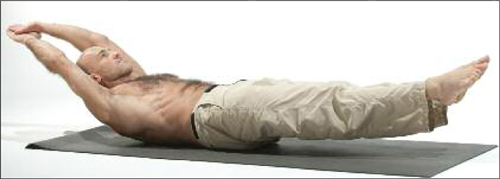

Breathe shallow and rock back and forth without losing this position. Your body must remain one stiff piece—there should be no movement in the hips, ribs, or lower back whatsoever, no stretching of the abs. Movement indicates weakness. Unlike in the hanging leg raises and Hardstyle sit-ups where the abs are prime or assistant movers, in hollow rocks they are stabilizers. And, as Gray Cook has put it in his classic book Movement, “Stabilizers’… role is not to move in the presence of movement…”
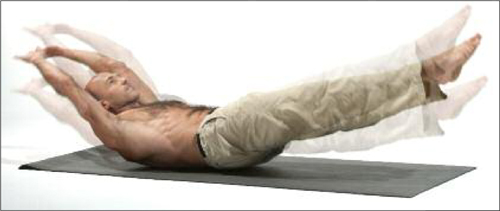

The “hollow rock”.

Letting your abbies open indicates weakness.
Rif recommends multiple sets of 10-15sec with the same amount of rest between sets. “Serious work here,” he promises.
Rolling side to side, from cheek to cheek, is another variation of the hollow drill. Make sure your upper and lower body roll as a unit, with no delay.
Whether you are hollow “rocking” or “rolling”, you may squeeze a water bottle, empty or filled, with a cap on between your ankles.
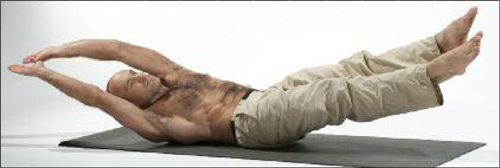

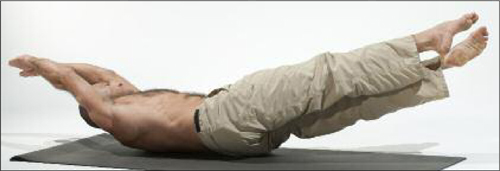

The upper body lagging behind the lower body or vice versa indicates weakness.
This exercise, in addition to carving a nice set of abs, will increase your strength in practically anything.
Just as practicing partial pullups is not likely to enable you to do a full one, partial HLRs will help but will not take you all the way. Hanging knee raises, although they seem like a natural regression, are a waste of time. The feeling of this exercise is too different from the real deal HLR. Russian and Bulgarian gymnastics coaches solve the problem with a contraption similar to the Total Gym®. Chuck Norris should not feel embarrassed to endorse this product. Many Russian gymnasiums are equipped with stall bars, wooden ladder like contraptions mounted on the wall. This old-fashioned rig is very versatile for strength and flexibility training. Relevant to our cause, it usually comes with a six-foot long board with hooks on one end. You park one end of the board on the floor and hook the top on a stall bar at your chosen level. A cart, big enough to park your upper body on comfortably, slides up and down the board on wheels. This contraption enables even the weakest to perform hard moves like the handstand pushup and even the iron cross. Adjust the angle of the board to your strength level—the flatter the board, the easier the exercise—and you are in business. The coach will mount a set of gymnastic rings near the athlete’s head, and the latter will be able to do a perfect cross! Soviet research is definite: this approach of performing the target exercise in a properly unloaded manner is far superior to the traditional method of simultaneous general strength training and lead-up exercises.54
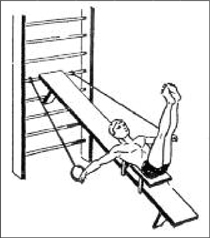
The hanging leg raise is built in the same manner: start with the board flat on the floor, hold onto the bar, and go. As you get stronger, progressively elevate the head. This works great, the only problem is: stall bars, not to mention boards with carts, are not to be found in the US. So I was guilty of pushing ineffective hanging knee raises on unsuspecting Americans until I finally figured out a way to use standard US gym equipment. A power rack—or even a training partner and a broomstick—is all you need.


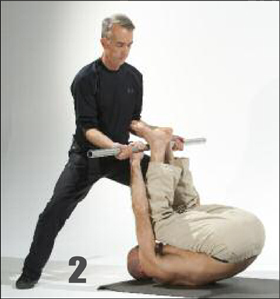
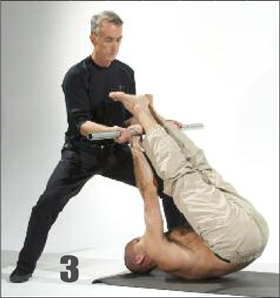
The floor Hardstyle leg raise.
Lie on your back and grab one of the safety pins set low with the familiar grip. Do not stretch your arms in line with the body like a diver. Gymnasts refer to the above position as the “open shoulders”. While this is your eventual goal, today you will train with relatively “closed shoulders” (less flexion), with your elbows approximately at your eye level. This is a much stronger and safer position. Adjust the height of the safety pin in the cage accordingly.
You will be working only the top ½ to ⅔ of the range of motion. Why limit the range of motion?—First, because you have already trained the bottom of the ROM with partial HLRs on a bar. Second, according to specialists from the former Soviet Union, the first 40-45 degrees of the HLR work the legs more than the abs.55 Third, supine leg raises are hard on the back and not the abs.56 Fourth, because I was extremely impressed with the effects of partial HLRs—L-seat to the top—when I spent a few months training under Ivan Ivanov, formerly one of the coaches for the Bulgarian National Gymnastics Team.
As before, you will start from the top, from full contraction. Get to the bar the safe and easy way. Bend your knees all the way and bring your knees towards your chest. Straighten out your legs and touch the bar with your insteps. Stay.
Take a breath, push down on the bar, and Hardstyle breathe in a familiar series of hisses until you have blown out most of your air and hopefully cramped every muscle on the front of your body.
At the same time push your insteps hard through the bar, as if you are determined to leave bloody welts on your skin. This will build your strength to finish a real hanging leg raise.
Without releasing the tension or stopping to push down on the bar, lower your legs until they form a ninety degree angle with your body. Inhale into your stomach through your nose on the way down.
Pause in the “L-seat” momentarily while staying tight, then power back up without thinking about your breathing. When your insteps touch the bar, perform the familiar series of hisses. I got the idea of forceful exhalation on the top of the HLR from a book by Dr. Michael Colgan and it has made a powerful difference in my training.
Do 3-5 sets of 3-5 reps of this exercise with 3-5min of rest between them. Do not forget to stretch. Train three times a week alternating this floor drill and the partial hanging leg raise. Say “See you later” to Hardstyle sit-ups for the time being.
Let us work on a subtle advanced technique of “manipulating space in the body” in order to achieve greater strength and flexibility. Old time strongmen loved tearing chains by expansion of their ribcages. Modern girevoy sport competitors drive kettlebells off their chests in the jerk by explosively opening their chests. You are going to do the opposite of this action to make your HLR stronger.
Imagine that your torso has been spray painted with red paint. Now finish your supine leg raise in such a manner that every spot on the front, from your armpits to your pelvis, has gotten darker. This can only happen when the same amount of paint is spread over a smaller surface. The surface of your skin will shrink when your muscles, some visible and some not, shorten. Your six-pack, external and internal obliques, TVA, serratus, internal intercostals, lats, pecs, major and minor... You don’t need to be an expert anatomist, just contract—shorten—whatever you can.
It is logical that if you aim to minimize the space in the front of the torso, you want to maximize it on the back side. While the front contracts to blood red, the back stretches to pink. (It is a good thing that it is on your back and you don’t have to look at it. Pink is a weak color. There is research showing that looking at it even briefly reduces your grip strength.)
Flexing the spine is not enough, your shoulder blades need to separate and give you a hump. This happens to be the job of the serratus anterior, the cool looking rib like muscles above your obliques. They are not just for looks though. The serratus has several functions, discussing which is outside the scope of this book, but the fact that it is informally known as the “boxer’s muscle” should tell you that any self-respecting hard Comrade ought to train it. Indeed, one of the serratus’ jobs is rolling the shoulder forward during a knockout cross. When you push down on the bar in the HLR, obviously you are not using your arms only; the serratus is a major player.

Floor Hardstyle leg raise progressions.
But don’t worry about all this anatomy, just try to “close the space” in the front of your torso when your insteps are pushing through the bar and forcefully expelling your air. On every set pick a different spot on the front of your torso and give it special attention.
At some point you will be comfortably doing sets of five reps. Stay there for several sessions and try to get a greater contraction every time.
Then progress to the next level by slightly elevating your shoulders above your hips. You will need to place some heavy object—your training partner’s feet and knees will do—behind you to prevent you from sliding. You will also need to move the pin up. Note that I don’t yet want you to bring yours arms in line with your ears as they will be when you are hanging on the bar yet; for now stay with the easier partially closed (extended) shoulder.
At this angle you will be getting less help from gravity. Eventually progress to the point where you are sitting upright—but with the bar still slightly in front and not directly overhead.

How to improvise the L-seat HLR on the road. Even if you have mastered the hanging version, you can make the floor one as hard as you want by focusing on tension. You may use a TRX® rig instead of a broomstick. Obviously, you will sit quite a ways from the door.
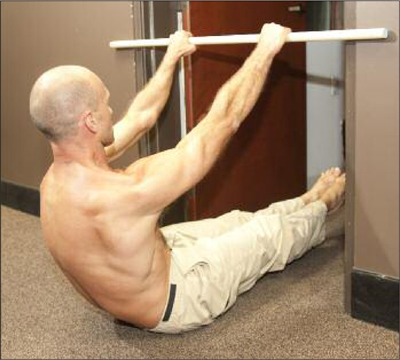
If no stick is available you may simply push your hands against the doorway. Not everyone’s shoulders will like it.
You are ready to graduate to the “real” hanging leg raise. You already know how to do it, you just need to learn one subtlety concerning the negative.
On the way down reengage the glutes—contract them—when your legs have almost reached the L-seat position. This will make the bottom half of the exercise more intense while unloading your back.


On the way down reengage the glutes at this point.
On the bottom, as in Hardstyle sit-ups, you have two options. Either stay tight and power back up. Or relax completely, let your bad breath out, and allow your spine stretch for a second before inhaling and reengaging the tension for the next rep.

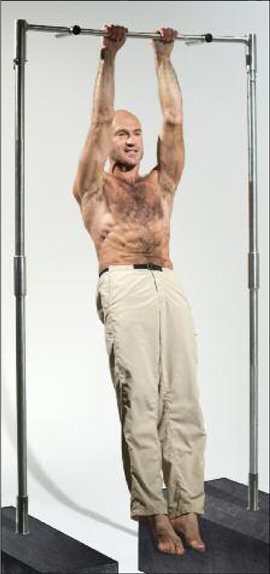
Loose or tight: two ways to separate your reps.
You can bring some variety into your HLR training by changing your grip. In addition to the narrow thumbless grip use the shoulder width grip with the thumbs around the bar. Do not forget the parallel narrow grip either. Rif is a big fan of HLRs on rings, as this piece of equipment gives the shoulders the freedom to move the way they wish to.
As you get stronger, consider the following more advanced HLR variations. Remember to Hardstyle breathe and cramp everything on the top of each rep.
1) HLR touching the bar with the shins, instead of the insteps. According to Dr. Ivan Belsky, sports scientist and elite strength coach, this variation maximally engages the abs.
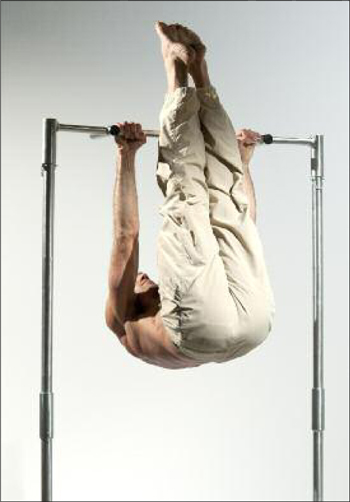
HLR touching the bar with the shins.
2) Top half HLR, from the L-seat to the top and back.


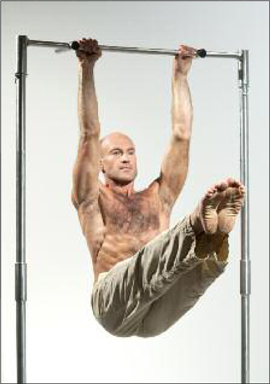
Top half HLR.
3) Top half HLR with pauses in the L-seat. “Back in the primordial days of yore,” wrote Marty Gallagher on the subject of paused lifts, “men sought to make lifts more difficult: nowadays men seek ways to make lifts easier. We resurrect this ancient philosophy of making resistance training hard—ponder the irresolvable contradiction of making resistance training easier.”
Ivan Ivanov had me do the following nasty: (1sec L-seat hold + 1 rep), (2sec L-seat hold + 2 reps), etc., all the way up to 10 (I had to be helped towards the end). This is way too many reps for the Hardstyle plan, but you get the idea. Something like three reps with 3sec holds will do the trick.
Pausing on the top, pressing the insteps through the bar for a few seconds, is another option. Combining pauses at the top and in the L-seat is even better. You may also introduce pauses at both mid and top positions of a full range HLR.
4) HLR with ankle weights. The author of excellent book Building the Gymnastic Body, Chris Sommer comments: “Except for occasional forays to break up the monotony of training and some specialized equipment exercises, I do not train my athletes with high repetitions during physical preparation. I am far more interested in the generation of athletic power than I am in the development of endurance. The stronger and more powerful an athlete is, the higher the degree of athleticism they will be capable of exhibiting. To that end, I find that weighted leg lifts are the far more beneficial choice for future athletic excellence then endless high rep sets of the weightless variety.”


Weighted HLR.
5) Angled HLR. A simple way to make the HLR tougher and to challenge your external obliques more is to touch the bar with your shins not in the center but slightly—slightly!—outside one of the hands. This variation calls for the narrow grip.
The secret to the angled HLR is pulling harder with one arm—without bending either. Visualize your lats, pecs, serratus, and external obliques on the working side maximally shortening, closing your ribs, and bringing your pelvis and your ribs together on one side. A good way to implement this variation into your program is three way HLRs: left-right-straight for a triple or left-right-left-right-straight for a fiver.
Do not bother with “windshield wipers”. They will not challenge your midsection but they will hurt your shoulders.
Do not attempt one-arm HLRs; it is a party trick, not an exercise. You will be too busy worrying about not ripping your shoulder out of the socket to work your abbies well.


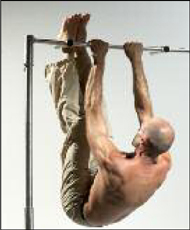
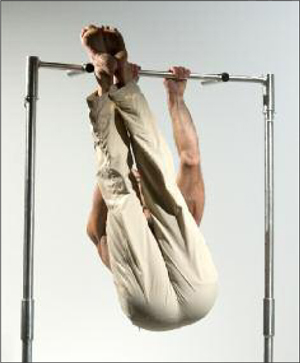
Angled HLR.
6) The Hardstyle HLR—Hardstyle breathing all the way. A friend of mine, an exceptionally strong man, called me up the day after I had him try the following version. “Were you trying to kill me? I did only three reps and I still feel my entire abdominal wall.”
Normally you have hissed on the bottom, to take the slack out of the body, and the very top, to get a cramp, without worrying about your breathing in the middle. Now keep hissing all the way. It is evil.
Although it is the usual series of short hisses rather than one long hiss, do your best to make the movement of the legs smooth and not jerky. You may hiss on the negative as well. Do not think about inhalation, it will take care of itself as you will automatically “sip” air between hisses.
This variation is a form of internal isometrics; you can make it as hard as you wish.
Sissies hate the hanging leg raise because it is excruciatingly tough. It takes real strength in the waist and the lats, something the high rep crunch generation does not possess. It also takes flexibility and most muscle men are about as limber as astronauts in Moon suits. You have two choices. You could keep whining about how hard it is to hold on to the bar, how much your shoulders hurt, and how you do not feel anything in your abs. Or, you could rise up to the challenge. The bar is set high and it is waiting.